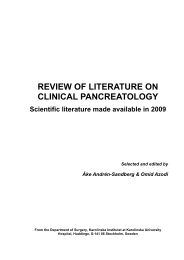Download PDF - The Pancreapedia
Download PDF - The Pancreapedia
Download PDF - The Pancreapedia
You also want an ePaper? Increase the reach of your titles
YUMPU automatically turns print PDFs into web optimized ePapers that Google loves.
incidence) and almost regularly involves the<br />
common pancreatic duct (Fig. 34). Since<br />
inflammation occurs around the hyperplastic<br />
areas, it is hard to decide whether the<br />
inflammation is the cause or sequence of<br />
hyperplasia. In other strains, a lower incidence<br />
(1%) of this type of lesion has been reported 133 . It<br />
must be pointed out that in small laboratory<br />
animals such as SGH, the "relative" incidence of<br />
specific tumors depends on the histological<br />
methods employed. <strong>The</strong> serial sectioning<br />
technique, of course, guarantees an approach<br />
more likely to determine the "real" value.<br />
Figure 34. Papillary hyperplasia of the common<br />
pancreatic duct. Note the mild peri-ductal<br />
inflammatory reaction. H&E, X 50.<br />
In contrast to endocrine tumors, which occur<br />
predominantly in males, spontaneous tumors of<br />
the exocrine parenchyma do not show significant<br />
sex preferences. Although they have been found<br />
only in males in some colonies, the lower<br />
incidence of these spontaneous tumors<br />
invalidates any conclusions as to sex preference.<br />
Nevertheless, under experimental conditions,<br />
females and males respond similarly, although<br />
males are relatively more sensitive to the toxic<br />
effects of the carcinogen, which is expressed by<br />
their earlier death during the experiment.<br />
Ductular tumors are within the range of<br />
spontaneously occurring tumors in many hamster<br />
colonies. <strong>The</strong>y are definitely age-related lesions<br />
and do not develop before 90 weeks in the Eppley<br />
colony or 78 weeks in the Hannover colony 79 . <strong>The</strong><br />
incidence of ductular adenomas in the Eppley<br />
32<br />
colony was around 1%; in the Hannover colony,<br />
1.5% 79 and in the Lakeview colony, around 2% 133,<br />
134 . We observed local or multi-focal cystic<br />
ductular tumors ranging between 1 to 3-mm nodules<br />
(Fig. 35). Most of these tumors were located<br />
in the tail of the splenic lobe, the largest<br />
pancreatic segment in SGH.<br />
Figure 35. Ductular adenoma in a 65-week-old<br />
female hamster. <strong>The</strong> lesions are encircled by a thin<br />
fibrous capsule. <strong>The</strong> involved islets (I) are cystic<br />
with the rest of the islet cells fragmented. Note the<br />
presence of inflammation (arrowhead) and ganglia<br />
(arrow). H&E, X 32.<br />
Spontaneous pancreatic adenocarcinomas were<br />
not found in either the Eppley or Hannover<br />
colonies. However, these tumors have been<br />
reported in the Lakeview colony in a 0.3 to 1%<br />
incidence 133, 134 . Adenocarcinomas are described<br />
as a solid gray-white or hemorrhagic nodule of<br />
variable sizes.<br />
Most observed and reported endocrine tumors in<br />
hamsters are of a spontaneous nature 78, 133-136 .<br />
<strong>The</strong>y develop occasionally in association with<br />
ductular neoplasms, either as solid or more<br />
frequently as mixed, ductular-insular cell tumors 87,<br />
101 (Fig. 36). Islet cell tumors are characterized by<br />
an immense vascularity that results in grayish red<br />
or brownish-red nodules ranging in size between<br />
1 to 30 mm. <strong>The</strong>y can be of multi-focal origin (up<br />
to four tumors), especially in the case of induced<br />
lesions, 67% of which were multi-centric 137, 138 .<br />
Adenomas can coincide with carcinomas in the<br />
same animal. In analogy to the human situation,<br />
most tumors (either spontaneous or induced)<br />
arise in the tail region of the splenic lobe. <strong>The</strong>












